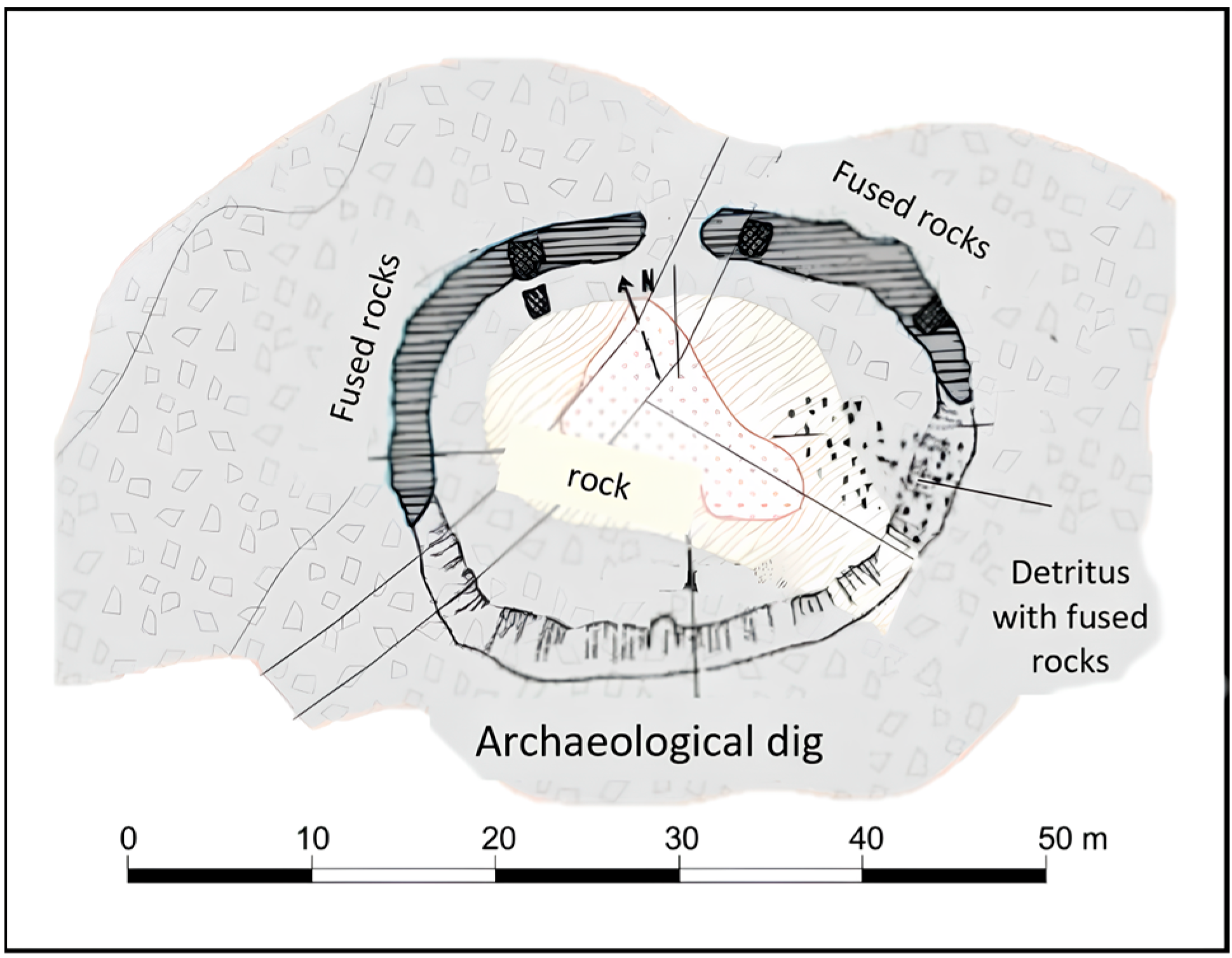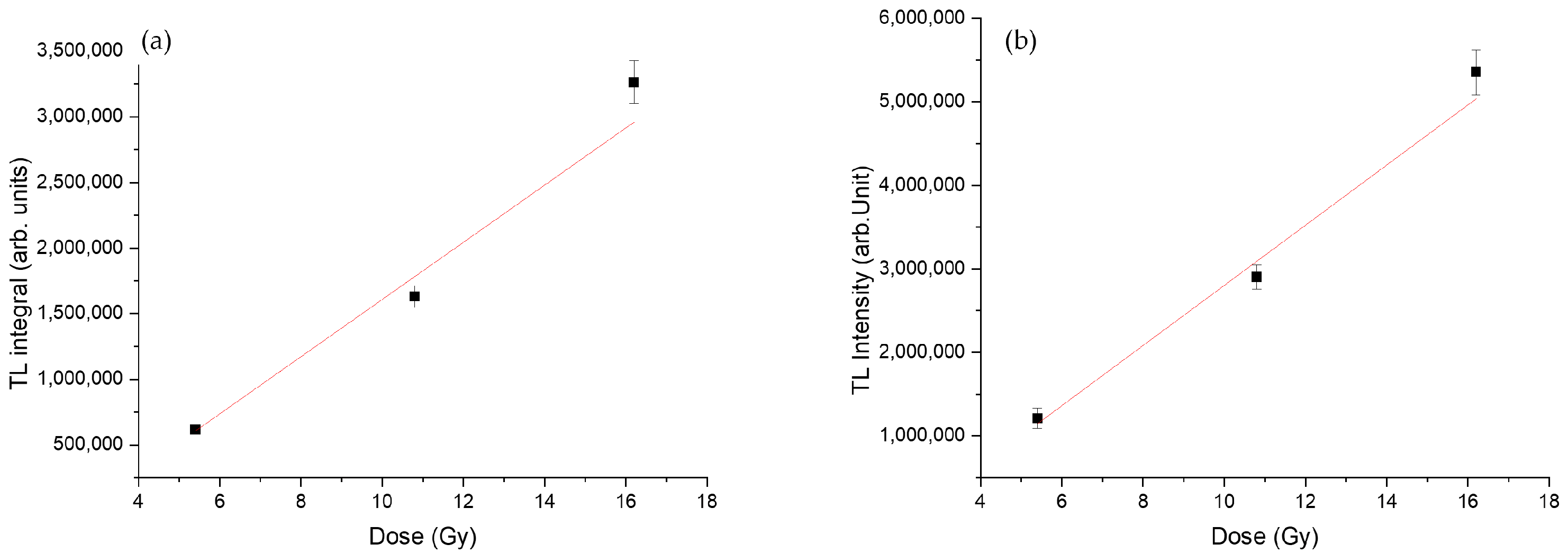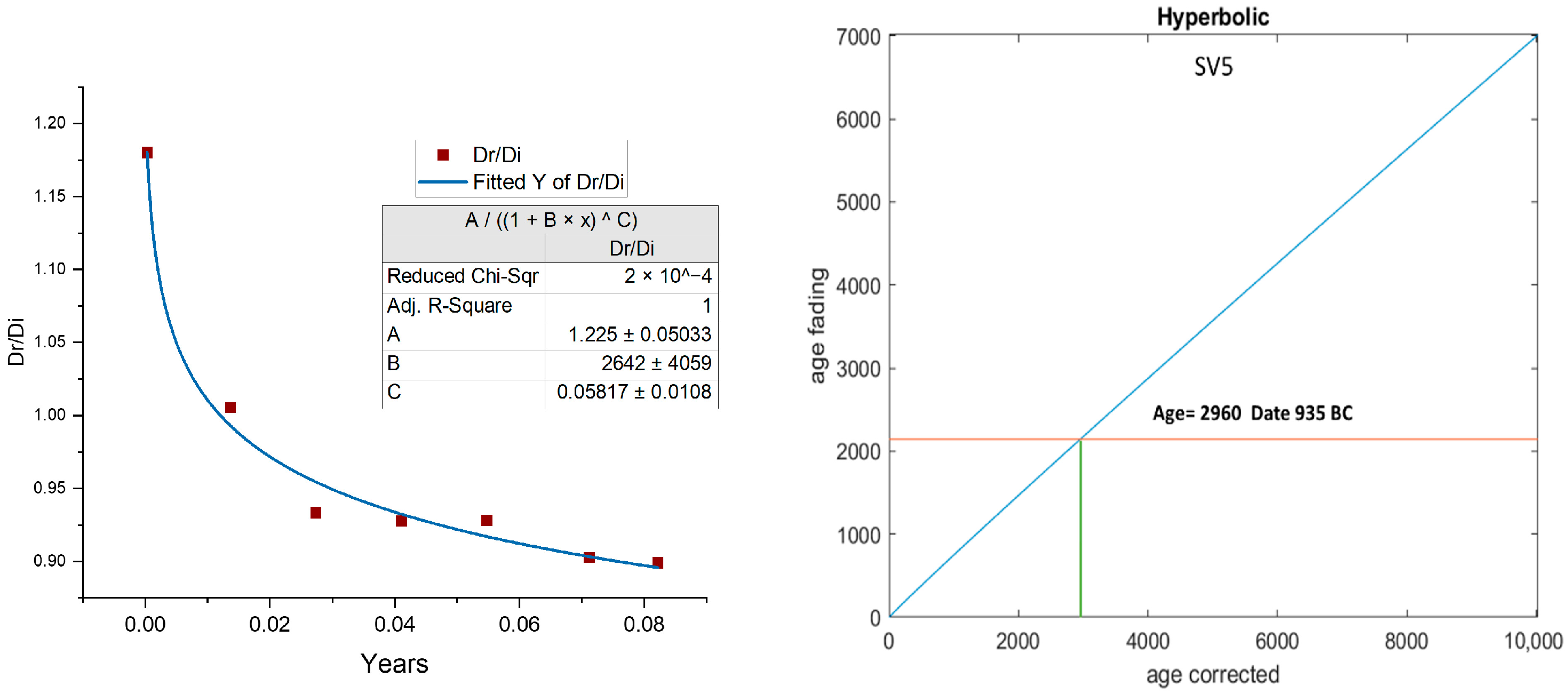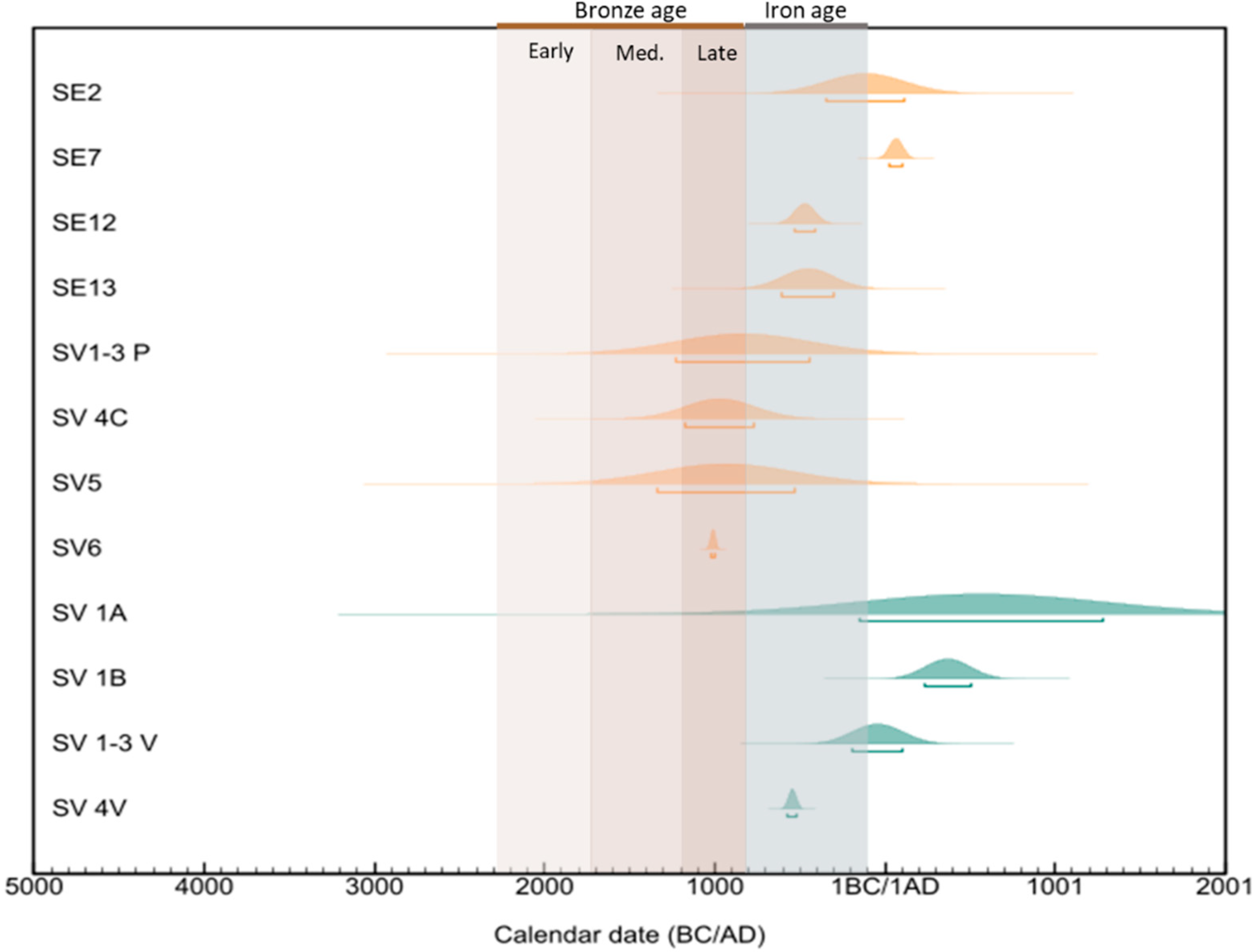Tracing the Origins of an Anthropic Vitrified Structure with “Pre-Bleached with Blue LED” Thermoluminescence Dating: The Enigmatic Serravuda Hilltop Fortification in Calabria, Italy
Abstract
1. Introduction
1.1. Serravuda’s Rocks Geology and Morphology
Generalities on the Structure of Vitrified Rocks
1.2. Dating Vitrified Structures
2. Materials and Methods
2.1. Samples
2.2. Thermoluminescence Methodology
Dose Rate Evaluation
2.3. Measurement Protocol
2.4. Anomalous Fading Correction
3. Results
4. Discussion
4.1. Age Results Discussion
4.2. The Purpose behind the Serravuda Hilltop Structure
4.3. Vitrification Techniques in Ancient Anthropic Structure and Proposed Scenario at Serravuda
5. Conclusions
Author Contributions
Funding
Data Availability Statement
Acknowledgments
Conflicts of Interest
References
- M’Hardy, C.B. On Vitrified Forts, with Results of Experiments as to the Probable Manner in Which Their Vitrification May Have Been Produced. Proc. Soc. 1906, 40, 136–150. [Google Scholar]
- Childe, V.G. Excavation of the Vitrified Fort of Finavon, Angus. Proc. Soc. Antiqu. Scotl. 1935, 69, 49–80. [Google Scholar] [CrossRef]
- Childe, V.G.; Thorneycroft, W.; Desch, C.H. The Vitrified Fort at Rahoy, Morvern, Argyll. Proc. Soc. Antiqu. Scotl. 1938, 72, 23–43. [Google Scholar] [CrossRef]
- McCloy, J.S.; Marcial, J.; Clarke, J.S.; Ahmadzadeh, M.; Wolff, J.A.; Vicenzi, E.P.; Bollinger, D.L.; Ogenhall, E.; Englund, M.; Pearce, C.I.; et al. Reproduction of Melting Behavior for Vitrified Hillforts Based on Amphibolite, Granite, and Basalt Lithologies. Sci. Rep. 2021, 11, 1272. [Google Scholar] [CrossRef] [PubMed]
- Sanderson, D.C.W.; Placido, F.; Tate, J.O. Scottish Vitrified Forts: TL Results from Six Study Sites. Int. J. Radiat. Appl. Instrum. Part D Nucl. Tracks Radiat. Meas. 1988, 14, 307–316. [Google Scholar] [CrossRef]
- Sanderson, D.C.W.; Placido, F.; Tate, J.O. Scottish Vitrified Forts: Background and Potential for TL Dating. Nucl. Tracks Radiat. Meas. 1985, 10, 799–809. [Google Scholar] [CrossRef]
- Friend, C.R.L.; Kirby, J.E.; Charnley, N.R.; Dye, J. New Field, Analytical Data and Melting Temperature Determinations from Three Vitrified Forts in Lochaber, Western Highlands, Scotland. J. Archaeol. Sci. Rep. 2016, 10, 237–252. [Google Scholar] [CrossRef]
- Kresten, P.; Ambrosiani, B. Swedish Vitrified Forts—A Reconnaissance Study. J. Swed. Antiqu. Res. 1992, 1–17. [Google Scholar]
- Berrocal-Rangel, L.; García-Giménez, R.; Ruano, L.; Vigil de la Villa, R. Vitrified Walls in the Iron Age of Western Iberia: New Research from an Archaeometric Perspective. Eur. J. Archaeol. 2019, 22, 185–209. [Google Scholar] [CrossRef]
- Catanzariti, G.; McIntosh, G.; Monge Soares, A.M.; Díaz-Martínez, E.; Kresten, P.; Osete, M.L. Archaeomagnetic Dating of a Vitrified Wall at the Late Bronze Age Settlement of Misericordia (Serpa, Portugal). J. Archaeol. Sci. 2008, 35, 1399–1407. [Google Scholar] [CrossRef]
- Bertolani, M. An Enigmatic Outcrop of Vitrified Rocks near Acri (Cosenza). Boll. Soc. Geol. Ital. 1972, 91, 683–692. [Google Scholar]
- Elmi, C.; Cipriani, A.; Lugli, F.; Sighinolfi, G. Insights on the Origin of Vitrified Rocks from Serravuda, Acri (Italy): Rock Fulgurite or Anthropogenic Activity? Geosciences 2021, 11, 493. [Google Scholar] [CrossRef]
- Foggia, F.; Sighinolfi, G.P.; Tosatti, G. Lithological Features and Provenance of the Material Used for the Construction of the Serravuda Hilltop Vitrified Structure (Calabria, Italy). Atti. Soc. Nat. Mat. Modena 2024, 1–12, in press. [Google Scholar]
- Doglioni, C.; Flores, G. Encyclopedia of European and Asian Regional Geology; Moores, E.M., Fairbridge, R.W., Eds.; Springer: Dordrecht, The Netherlands, 1997; pp. 414–435. [Google Scholar]
- Bertolani, M.; Foggia, F. La Formazione Kinzigitica Della Sila Greca. Boll. Soc. Geol. It. 1975, 91, 683–692. [Google Scholar]
- Borrelli, L.; Critelli, S.; Gulla, G.; Muto, F. Rilievo del Grado di Alterazione delle Rocce Cristalline; Presentazione della Carta del Grado di Alterazione e dei Movimenti di Massa della Porzione Centro-Occidentale del Bacino Del F. Mucone; Geologi Calabria: Catanzaro, Italy, 2011; pp. 3–46. [Google Scholar]
- Nisbet, H.C. A Geological Approach to Vitrified Forts. Sci. Archaeol 1974, 12, 3–12. [Google Scholar]
- Greig, C. Excavations at Castle Point, Troup, Banffshire. Aberdeen Uni. Rev 1970, 43, 274–283. [Google Scholar]
- Mackie, E.W. The Vitrified Forts of Scotland; Academic Press: Cambridge, MA, USA, 1976. [Google Scholar]
- Daniels, F.; Boyd, C.A.; Saunders, D.F. Thermoluminescence as a Research Tool. Science 1953, 117, 343–349. [Google Scholar] [CrossRef]
- Aitken, M.J. Thermoluminescence Dating; Academic Press: London, UK, 1985. [Google Scholar]
- Galli, A.; Sibilia, E.; Martini, M. Ceramic Chronology by Luminescence Dating: How and When It Is Possible to Date Ceramic Artefacts. Archaeol. Anthropol. Sci. 2020, 12, 190. [Google Scholar] [CrossRef]
- Wagner, G.A. Age Determination of Young Rocks and Artifacts Physical and Chemical Clocks in Quaternary Geology and Archaeology; Natural Science in Archaeology; Springer: Berlin/Heidelberg, Germany, 1988. [Google Scholar]
- Sanderson, D.C.W.; Warren, S.E.; Hunter, J.R. The TL Properties of Archaeological Glass; Risoe National Laboratory: Roskilde, Denmark, 1983; ISBN 87-550-0915-8. [Google Scholar]
- Galli, A.; Poldi, G.; Martini, M.; Sibilia, E.; Montanari, C.; Panzeri, L. Study of Blue Colour in Ancient Mosaic Tesserae by Means of Thermoluminescence and Reflectance Measurements. Appl. Phys. A 2006, 83, 675–679. [Google Scholar] [CrossRef]
- Discher, M.; Woda, C. Thermoluminescence of Glass Display from Mobile Phones for Retrospective and Accident Dosimetry. Radiat. Meas. 2013, 53–54, 12–21. [Google Scholar] [CrossRef]
- Galli, A.; Caccia, M.; Martini, M.; Panzeri, L.; Maspero, F.; Fiorentino, S.; Vandini, M.; Sibilia, E. Applying the “Pre-Bleached with Blue LEDs” Protocol to Date Umayyad Mosaic Tesserae by Thermoluminescence. Quat. Geochronol. 2019, 49, 218–222. [Google Scholar] [CrossRef]
- Guérin, G.; Mercier, N.; Adamiec, G. Dose-Rate Conversion Factors: Update. Anc. TL 2011, 29, 5. [Google Scholar]
- Wintle, A.G. Anomalous Fading of Thermo-Luminescence in Mineral Samples. Nature 1973, 245, 143–144. [Google Scholar] [CrossRef]
- Huntley, D.J.; Lamothe, M. Ubiquity of Anomalous Fading in K-Feldspars and the Measurement and Correction for It in Optical Dating. Can. J. Earth Sci. 2001, 38, 1093–1106. [Google Scholar] [CrossRef]
- Gualtieri, M. Fortifications and Settlement Organization: An Example from pre-Roman Italy. World Archaeol. 1987, 19, 30–46. [Google Scholar] [CrossRef]
- Castagna, M.A.; Ferranti, F.; Levi, S.T.; Luppino, S.; Peroni, R.; Schiappelli, A.; Vanzetti, A. Broglio di Trebisacce, Cittavetere di Saracena, Colle Dogna di Acri, Campagna 1999. In Proceedings of the Convegno Magna Grecia e Oriente Mediterraneo Prima dell’età Ellenistica, Taranto, Italy, 1–5 October 1999. [Google Scholar]
- Castagna, M.A.; Schiappelli, A. La Sequenza Stratigrafica di Acri-Colle Dogna (CS), Tra Eneolitico e Bronzo Antico. In Proceedings of the Atti della XXXVII Riunione Scientifica dell’Istituto Italiano diPreistoria e Protostoria, Tortora, Italy, 29 September–4 October 2002. [Google Scholar]
- Jung, R.; Mommsen, H.; Pacciarelli, M. From West to West: Determining Production Regions of Mycenaean Pottery of Punta di Zambrone (Calabria, Italy). J. Archaeol. Sci. Rep. 2015, 3, 455–463. [Google Scholar] [CrossRef]
- Marino, D.; Pacciarelli, M. Calabria. L’antica Età Del Bronzo. Articolazioni Culturali e Cronologiche. In Proceedings of the Atti del Congresso Nazionale “L’antica età del Bronzo in Italia”, Viareggio, Italy, 9–12 January 1995; pp. 147–162. [Google Scholar]
- Taliano Grasso, A.; Marino, D.; Nicoletti, G.; Medaglia, S. Rocche Protostoriche e Abitati Brettii Tra Sila e Mare Jonio. In Proceedings of the Atti Convegno Internazionale Centri Fortificati Indigeni della Calabria dalla Protostoria all’età Ellenistica, Napoli, Italy, 16–17 January 2014. [Google Scholar]
- Sevink, J.; De Neef, W.; Vito, M.A.D.; Arienzo, I.; Attema, P.A.; Van Loon, E.E.; Ullrich, B.; Den Haan, M.; Ippolito, F.; Noorda, N. A Multidisciplinary Study of an Exceptional Prehistoric Waste Dump in the Mountainous Inland of Calabria (Italy): Implications for Reconstructions of Prehistoric Land Use and Vegetation in Southern Italy. Holocene 2020, 30, 1310–1331. [Google Scholar] [CrossRef]
- Mackie, E.W. Timber-Laced and Vitrified Walls in Iron Age Forts: Causes of Vitrification. Glasg. Archaeol. J. 1969, 1, 69–71. [Google Scholar] [CrossRef]
- Brothwell, D.R.; Bishop, A.C.; Woolley, A.R. Vitrified Forts in Scotland: A Problem in Interpretation and Primitive Technology. J. Archaeol. Sci. 1974, 1, 101–107. [Google Scholar] [CrossRef]
- Kresten, P.; Goedicke, C.; Manzano, A. TL-Dating of Vitrified Material. Geochronometria 2003, 22, 9–14. [Google Scholar]
- Youngblood, E.; Fredriksson, B.J.; Kraut, F.; Fredriksson, K. Celtic Vitrified Forts: Implications of a Chemical-Petrological Study of Glasses and Source Rocks. J. Archaeol. Sci. 1978, 5, 99–121. [Google Scholar] [CrossRef]
- Smith, D.C.; Vernioles, J.D. The Temperature of Fusion of a Celtic Vitrified Fort: A Feasibility Study of the Application of the Raman Microprobe to the Non-Destructive Characterization of Unprepared Archaeological Objects. J. Raman Spectrosc. 1998, 28, 195–198. [Google Scholar] [CrossRef]
- Wadsworth, F.B.; Heap, M.J.; Damby, D.E.; Hess, K.-U.; Najorka, J.; Vasseur, J.; Fahrner, D.; Dingwell, D.B. Local Geology Controlled the Feasibility of Vitrifying Iron Age Buildings. Sci. Rep. 2017, 7, 40028. [Google Scholar] [CrossRef]
- Friend, C.R.L.; Dye, J.; Fowler, M.B. New Field and Geochemical Evidence from Vitrified Forts in South Morar and Moidart, NW Scotland: Further Insight into Melting and the Process of Vitrification. J. Archaeol. Sci. 2007, 34, 1685–1701. [Google Scholar] [CrossRef]






| Typology | Sample Code |
|---|---|
| Granitoid substrate rock unaffected by heating | SE9 |
| Heated or partially melted granitoid rocks fragments (6 samples) | SE2, SE6, SE13, SV1 3P, SV 4C, SV6 |
| Heated or partially melted metamorphic rocks fragments (3 samples) | SE7, SE12, SV5 |
| Vitreous cements (4 samples) | SV 1A, SV 1B, SV 1 3V, SV 4V |
| Sample | Water Content (%) | 238U (ppm; ±5%) | 232Th (ppm; ±5%) | 40K (ppm; ±3%) | Internal Dose Rate (mGy a−1; ±5%) | External Dose Rate (mGy a−1; ±5%) |
|---|---|---|---|---|---|---|
| SE9 | 7 | 0.37 | 20.75 | 1.21 | 1.52 | 0.62 |
| SE2 | 7 | 0.06 | 1.08 | 1.22 | 0.83 | 0.68 |
| SE6 | 7 | 0.09 | 1.03 | 1.22 | 0.83 | 0.62 |
| SE7 | 7 | 0.15 | 0.42 | 1.22 | 0.82 | 0.68 |
| SE12 | 7 | 0.26 | 1.29 | 1.22 | 0.87 | 0.68 |
| SE13 | 7 | 0.43 | 17.32 | 1.22 | 1.47 | 0.68 |
| SV 13P | 7 | 0.19 | 4.67 | 1.22 | 0.82 | 0.68 |
| SV 4C | 7 | 0.04 | 0.21 | 1.22 | 0.79 | 0.68 |
| SV5 | 7 | 0.14 | 1.95 | 1.22 | 0.87 | 0.68 |
| SV6 | 7 | 0.22 | 0.39 | 1.22 | 0.83 | 0.68 |
| SV 1A | 7 | 0.37 | 5.91 | 2.01 | 1.53 | 0.65 |
| SV 1B | 7 | 1.59 | 12.02 | 2.01 | 1.93 | 0.65 |
| SV 13V | 7 | 0.47 | 7.94 | 2.01 | 1.60 | 0.68 |
| SV 4V | 7 | 0.27 | 1.01 | 2.01 | 1.34 | 0.68 |
| Step | Treatment | |
|---|---|---|
| 1 | 500 s blue LED bleaching | Natural TL |
| 2 | TL 450 °C, 2 °C/s | |
| 3 | a 5.5 Gy (50 s β) b 11 Gy (100 s β) c 16.5 Gy (150 s β) | TL Growth |
| 4 | 500 s blue LED bleaching | |
| 5 | TL 450 °C, 2 °C/s |
| Step | Treatment | |
|---|---|---|
| 1 | TL 450 °C, 2 °C/s | Natural TL |
| 2 | a 5.5 Gy (50 s β) b 11 Gy (100 s β) c 16.5 Gy (150 s β) | TL Growth |
| 3 | TL 450 °C, 2 °C/s |
| Sample | Equivalent Dose (ED) (Gy) | Dose Rate (mGy y−1) |
|---|---|---|
| SE9 | 150.0 ± 39.0 | 2.09 ± 0.05 |
| SE2 | 3.28 ± 0.36 | 1.41 ± 0.05 |
| SE6 | 136.0 ± 19.0 | 1.40 ± 0.05 |
| SE7 | 2.73 ± 0.06 | 1.40 ± 0.05 |
| SE12 | 3.60 ± 0.08 | 1.44 ± 0.05 |
| SE13 | 2.93 ± 0.18 | 2.04 ± 0.05 |
| SV 13P | 3.99 ± 0.55 | 1.40 ± 0.05 |
| SV 4C | 4.10 ± 0.28 | 1.37 ± 0.05 |
| SV5 | 3.10 ± 0.42 | 1.44 ± 0.05 |
| SV6 | 4.26 ± 0.02 | 1.41 ± 0.05 |
| SV 1A | 3.43 ± 1.52 | 2.12 ± 0.05 |
| SV 1B | 4.16 ± 0.34 | 2.52 ± 0.05 |
| SV 13V | 3.50 ± 0.26 | 2.18 ± 0.05 |
| SV 4V | 3.68 ± 0.03 | 1.43 ± 0.05 |
| Sample Code | Proposed Age |
|---|---|
| Heated or partially melted granitoid rocks | |
| SE2 | 115 BCE ± 230 |
| SE13 | 450 BCE ± 150 |
| SV1 3P | 835 BCE ± 395 |
| SV 4C | 970 BCE ± 205 |
| SV6 | 1010 BCE ± 15 |
| Heated or partially melted metamorphic rocks | |
| SE7 | 67 CE ± 40 |
| SE12 | 470 BCE ± 60 |
| SV5 | 935 BCE ± 400 |
| Vitreous cements | |
| SV 1A | 566 CE ± 710 |
| SV 1B | 370 CE ± 130 |
| SV1 3V | 42 BCE ± 150 |
| SV 4V | 543 BCE ± 20 |
Disclaimer/Publisher’s Note: The statements, opinions and data contained in all publications are solely those of the individual author(s) and contributor(s) and not of MDPI and/or the editor(s). MDPI and/or the editor(s) disclaim responsibility for any injury to people or property resulting from any ideas, methods, instructions or products referred to in the content. |
© 2024 by the authors. Licensee MDPI, Basel, Switzerland. This article is an open access article distributed under the terms and conditions of the Creative Commons Attribution (CC BY) license (https://creativecommons.org/licenses/by/4.0/).
Share and Cite
Galli, A.; Saleh, M.; Foggia, F.; Sighinolfi, G.P. Tracing the Origins of an Anthropic Vitrified Structure with “Pre-Bleached with Blue LED” Thermoluminescence Dating: The Enigmatic Serravuda Hilltop Fortification in Calabria, Italy. Appl. Sci. 2024, 14, 4504. https://doi.org/10.3390/app14114504
Galli A, Saleh M, Foggia F, Sighinolfi GP. Tracing the Origins of an Anthropic Vitrified Structure with “Pre-Bleached with Blue LED” Thermoluminescence Dating: The Enigmatic Serravuda Hilltop Fortification in Calabria, Italy. Applied Sciences. 2024; 14(11):4504. https://doi.org/10.3390/app14114504
Chicago/Turabian StyleGalli, Anna, Miriam Saleh, Francesco Foggia, and Gian Paolo Sighinolfi. 2024. "Tracing the Origins of an Anthropic Vitrified Structure with “Pre-Bleached with Blue LED” Thermoluminescence Dating: The Enigmatic Serravuda Hilltop Fortification in Calabria, Italy" Applied Sciences 14, no. 11: 4504. https://doi.org/10.3390/app14114504
APA StyleGalli, A., Saleh, M., Foggia, F., & Sighinolfi, G. P. (2024). Tracing the Origins of an Anthropic Vitrified Structure with “Pre-Bleached with Blue LED” Thermoluminescence Dating: The Enigmatic Serravuda Hilltop Fortification in Calabria, Italy. Applied Sciences, 14(11), 4504. https://doi.org/10.3390/app14114504








